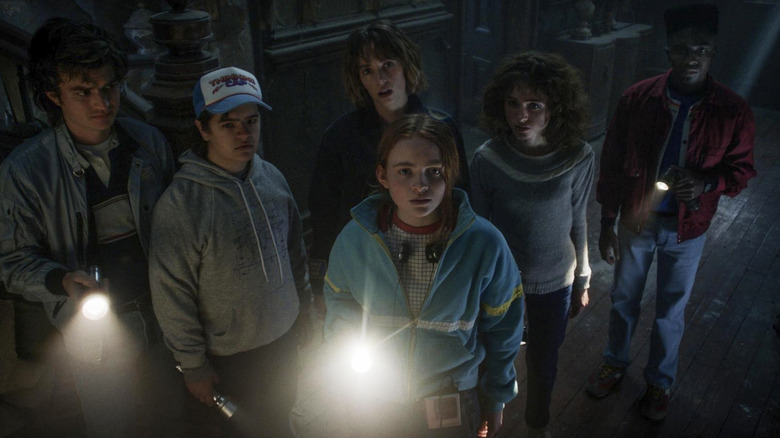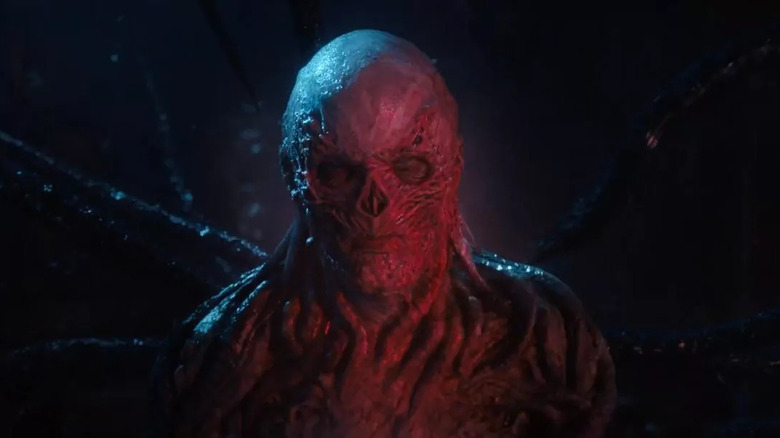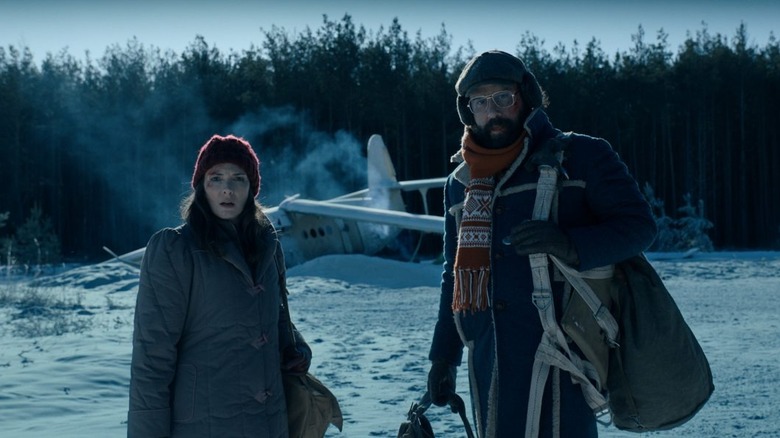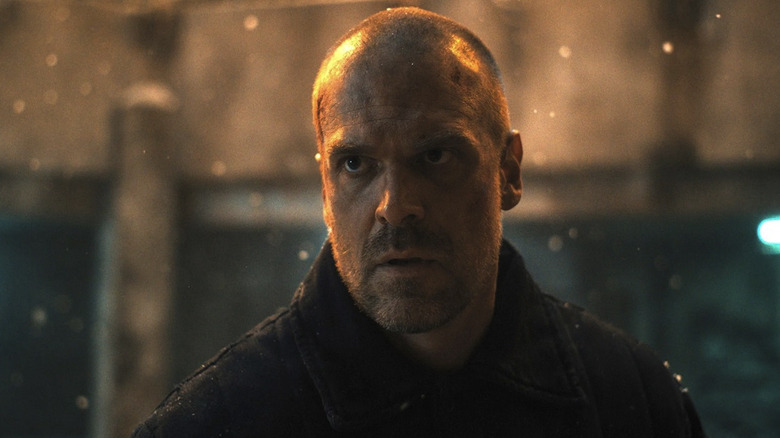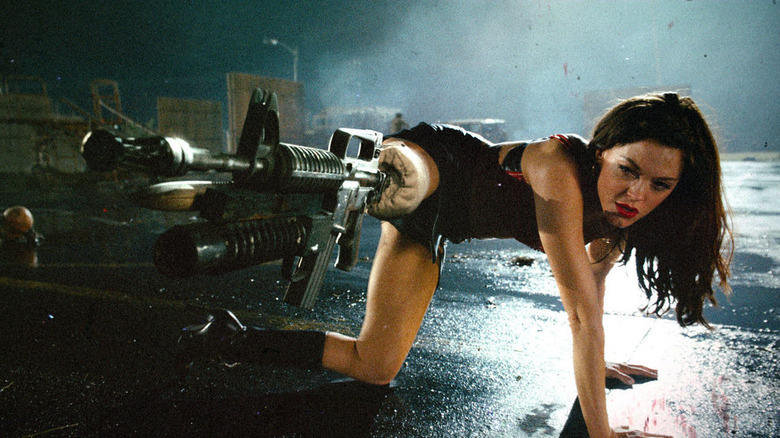Stranger Things Lead Sound Effects Editor Angelo Palazzo On The Magic Of IKEA Furniture And Vegetables [Interview]
Lead sound effects editor Angelo Palazzo is sometimes left speechless by season 4 of "Stranger Things." Palazzo previously won an Emmy for his work on season 3, but for him, season 4 was a whole new different beast. Although he has over 25 years of experience in moviemaking, nothing quite compares to working on the Duffer Brothers' hit Netflix show.
As the series matures with its main audience, season 4 takes a darker turn. As a result, so do the sound effects. Palazzo went darker and harder with the "Stranger Things" soundscape. Monsters are more aggressive and the hits hurt more than before. The lead sound effects editor, who's also worked with Robert Rodriguez many times in the past, recently told us about his work on "Stranger Things" season 4, his longtime collaboration with sound designer Craig Henighan, and fond memories from his experience on "Grindhouse." Spoilers ahead for season 4, volume 1.
'I went ahead and started recording a bunch of vegetables'
Did a lot of sound effects carry over from past seasons or did the change in tone alter a lot of the "Stranger Things" sound effects audiences know now?
So a lot of the stuff that did carry over was stuff that was initially established by Craig Henighan, the lead sound designer. Craig and I have worked together for over 15 years now. A lot of times he'll do design for something and then he'll go, "Can you take a shot at this?" He likes to kind of see where I go with it. And then we kind of exchange ideas.
With season 4, he was actually even jokingly saying, "Man, this is the fourth season. I'm kind of running out of ideas. Can you take a shot?" So what happened was I would take a lot of the foundational signature sounds that he built that everyone knows — for The Upside Down, the Demogorgons, and the dogs came back too — so I would get all that original material, and then I would kind of do the version 2.0 of that. I would take the source material and I would help to elevate it, make it more aggressive, because a lot of the whole season is leaning into the horror of it. There's a lot more violence. There's a lot more aggression. There's gore, maximum gore.
So the Demogorgons, I built a palette of much more aggressive attacking movements, more aggressive vocalizations, but it was all built off what we initially had there. It was a blast because anything goes. These things are such wild creatures. And then there was a whole salad of new things to design, too. But yeah, to answer your question, we definitely start with the foundational signature stuff, but it was very much like, "Do your thing, man. Go to the next level with all this, get more aggressive, get more gritty."
And then a newer character, a newer creature, was the bats, [which] was a big thing that came. I got into that back in October, they were sending me early scenes of this. Since it's like a mindhive, they're all interrelated, I knew I could hint at a bit of the Demogorgons with the vibe with the bats.
With the bats, they didn't want the typical just screechy sounds, you know? We were thinking about how do we make these things sound unique and organic, but also scary and foreign and terrifying? One of the things we came across, which is the f***ing weirdest thing that ended up working out great, was we tried typical things, pitching up lots of pig sounds and different things like that. [...] And then, what ended up working, I had this sliding closet door that's super squeaky. It has just the amount of screech and chittery sounds to it when you slide it. Craig also had a similar thing, so we ended up recording these sliding closet doors as the basis of these vocals. It just had the most aggressive quality to it that worked out awesome.
A lot of you may not know, but with sound design, a lot of the source material for creatures actually comes from real world things like that, wood bending and chittering wood, or screeching sounds, or scraping cardboard on cement, or dragging cinder blocks. Those are foundational sounds you can use for screaming. When you get cinder blocks on cement, you could get a good screeching sound out of that. So, with the bats, the wood ended up being a really, really unique element that played really well, really fun.
What did you use to create the sound for Vecna's movements?
With Vecna, I also got a lot of visual stuff early on, so I was able to build up a whole new palette of a lot of gore. We knew that his body would always be moving with the vines, and then there was going to be a whole other thing at the Creel house with the vines. So, I went ahead and started recording a bunch of vegetables, and cabbage, and twisting fibrous vegetables to create a whole new palette of gory, fibrous stuff that sounds like tendons: carrots snapping, peppers twisting. Also, I would wrap them in a wet cloth so it sounds like bones cracking underneath skin. We would just kind of twist those and get just a whole palette of wet vegetables, anything that's fibrous, and tomatoes.
And then, with that whole palette, I was able to get layers going whenever we'd see Vecna to kind of build his body movements. A lot of that material ended up helping with the vines at the Creel house, where there's all these crazy vines that attack the kids, and they tighten up around the neck and all that kind of twisting stuff.
Also, Lee Gilmore, one of our editors, had an awesome recording of these pumpkins that he had recorded crackling, cracking sounds. We used a lot of those, too.
Very eclectic.
That's part of the fun, doing sound. It's like anything goes, really. It's really about what sounds cool, what works, how you can kind of trick the mind to believe what you're seeing.
'The idea was to have an homage to Bruce Lee'
When we hear the kids' bones breaking in the show, how far and intense did you want those sound effects to go?
Dude, it's crazy. When I first saw the first episode ... I was like, "Wow, that's how we're going to go, okay. We're going to get pretty aggressive." It's pretty aggressive and violent, which I was cool with because I've done a ton of movies for Robert Rodriguez. I'm actually doing one right now for him. And he's leaned heavily into the Grindhouse world, a lot of gore. It's right in my wheelhouse, so I was like, "Oh, f***, we're going to go really into the gore here." So I got a lot of those scenes early and they wanted it to be pretty disturbing, pretty shocking. And so, it was a similar thing — we just went into like, "How can we get this to feel as disturbing?" I mean, they're breaking ... they're kids, you know?
It was actually shocking. We just leaned into it and just tried to make it hardcore, nasty, aggressive. The whole season is very aggressive. We definitely did that with the sound. Even, if you notice, with the stingers, and the risers, the jump scares, it's all just very aggressive, gritty, and a lot of feedback. We used a lot of feedback. There were a lot of distortions, things like that we went into.
Even though you got more aggressive with the sound effects, you also had more fun in some instances, like the airplane fight, right?
That's funny you mention it. I built a whole new palette of fight sounds for that to make it fun, but also hefty, because I wanted everyone to get a feel of like, "Wow. Murray can actually fight." I love that actor who plays Murray. I feel like he kind of steals every scene he's in. He's so funny.
Craig and I were talking about it and the idea was to have an homage to Bruce Lee, but not to [fully] go into the kung fu stuff, but to just give a little hint to it. If you notice, at the very end of the fight, there's a little hint of a gong going off.
Actually, we really went way Bruce Lee in the first pass. We had the Bruce Lee vocal, all the kung fu voice stuff that he did, little hints of it. At the end, we had the big gong. But the gong is still in there, it's just very subtle. It's that moment where he just knocked him out and it zooms in on him, and then we have the little Bruce Lee moment. But yeah, that was a blast. That was super fun to do that scene.
'Once I tell you what I use, you'll never hear it the same after that'
A contrast to that fight scene is Hopper's prison escape. You have explosions, gunshots, and the battle with chains and tools, not to mention a snowmobile. How massive of an undertaking was that action scene?
It was massive. The whole thing was just so big. We were all saying throughout the whole series how big it is. We all come from feature backgrounds, we're all weathered veteran feature film designers and editors, and we've also done episodic, but then this was a hybrid of the two. Hats off to the Duffers and the Zimmerman guys who cut the picture to this stuff, because the pasting is amazing. Like you said, all the moving pieces, but it all works, and the action is just this high-octane action that gets in and out of these scenes. It was like cutting a feature, it really was. I'm actually doing a movie now that is a feature and it feels like a walk in the park now compared to what we just did on "Stranger Things."
To your question, with Hopper, we were going for more of just realistic violence. With Hopper, the whole idea with the prison, the Russian scenes was, "This is brutal." The hits are nasty, the punches are painful, and they just feel real. We were going at it like, "How do we contrast these two fights?" It was mostly to keep his stuff raw and real-sounding.
I wanted to circle back to using vegetables for the sound of bones breaking. What are some other funny practical elements you were using for sound effects?
You know, it's funny, man. I'm so immersed in the sound world that I kind of figure, "Oh yeah, everybody knows that," but people don't know that. We use all kinds of stuff. Well, one thing, I designed a lot of the Creel house, the creaking, and I was trying to give it its own character of this breathing movement thing.
It's weird, because it's so funny when you talk about what you use, it can kind of take the magic out of it. In fact, I remember, I did the movie "Frozen II," and there was the thing called Gale, the wind spirit. After two editors had made an attempt, they gave it to me to try it. I did my version of it and the director loved it and then ended up in the movie, and the entire time they were asking me what I did. I actually said, "I can't tell you, because if I tell you, it'll ruin the movie for you." Once I tell you what I use, you'll never hear it the same after that.
But with "Stranger Things," I don't feel like it's so much the case, because a lot of it is very organic sounds. But with the Creel house, I had this old Ikea furniture that I was getting rid of. There were just these chairs that had these unbelievable creaks when you leaned into this stuff, and I'd had them for so long. I ended up taking the microphone, putting it underneath this footrest type thing. It had this amazing, deep, tonal, heavy, creaking wood sound that I recorded at 192 [kilohertz], which allows me, later, to pitch it down without having any weird artifacts in the audio.
I started with that, this piece of Ikea furniture, just really manipulating the wood, just stressing it, bending it as much as I could. It had these great bending sounds that worked incredibly for the Creel house. Once I pitch it down, and then I start layering in some other elements, and I get this breathing quality in the house, that this thing is weirdly alive, which we later find out it is when the vines come to life. It was something that really was an unusual source that helped out a lot with the Creel house.
'Push the boundaries and get out of the box here'
The Duffer Brothers are very referential. Obviously, this season is very indebted to "Nightmare on Elm Street." Do you ever pay homage or reference classic movie sound effects or techniques in "Stranger Things?"
Sometimes. There are some vocal moments with the house, I think, with some of the stingers, where we were doing a bit of reverse vocals, "Poltergeist"-style, just to hint at that early '80s reverse reverbs and reverse whispers and vocals into a moment or a hit. There's a lot of leading into scenes with the whole season, where you have a rising lead-in that drops you into some action in the next scene. The pushing movement, that momentum, worked well with a lot of these reversing, fluttery, "Poltergeist"-y sounds. That was one.
I actually went back and listened to some of the stuff that [composer and sound designer] Alan Howarth did, who I worked with way back when I started out. I was his assistant years ago and I asked him how he did all that stuff. I think it's pretty common knowledge, now, how he did it, but it was fun to be able to actually ask him, and Alan did all those "Halloween" sequels. I got a ton of great tips through the years from Alan, as far as approaching the horror movie genre.
I did look at the "Elm Street” stuff again, because, I mean, I don't think the Duffers are trying to hide any of that, either. They're right out there. I mean, part of the appeal of the show is for someone like me who grew up in the '80s. I was their age in '86. I was 15. So, to me, that's super-nostalgia. I think it's all about that. They're all about putting the influences right out there.
In chapter seven, the Demogorgon vs. the prisoners, obviously a lot is happening there. What was challenging about working on that fight sequence?
There's a massive thing. To be honest, the whole thing was so challenging. It really was, I feel like all of us, the whole sound team, everything we did took all of our game to the next level because honestly, none of us have worked on an episodic show that was this long, just in pure length of each episode, with this much action, this much sound design, the effects editorial was super stylized with all the fast cuts and the action scenes. It just took so much skill on this show, and everyone did such an awesome job. Any of the Demogorgon scenes were definitely challenging to know where the point was to notch them up to the next level. Their movements were more aggressive, the vocals were more aggressive.
As you said, some of the movies referenced, you were watching them when you were 15. When I was 15, I was watching "Grindhouse" in the theater. Since it's the 15th anniversary this year, any fond memories working on that movie?
Oh yeah, man. The first movie I did for Robert was "Sharkboy and Lavagirl." And then right after that was "Grindhouse," which, it's this crazy juxtaposition that he does, this crazy dichotomy of movies, where he's got these kids superhero movies and then these uber ultra-violent grindhouse movies. So that one was a blast because, my memory is just I couldn't believe we were going so far with the gore and the violence in these movies, but then it was so much fun that it was almost bordering on humor. He likes the campy, over-the-top stuff.
I kind of solidified my position with the crew on that movie because I just went full-on. I was like, "All right, I'm going to have a lot of fun with this. I'm going to go big." I created a lot of these over-the-top water slasher-type stuff, blood squirts. When there's blood in Robert's movies, it doesn't just splat — it squirts and it keeps going.
I guess my memory is knowing that I can push the limits, and it's a lot of fun working with people who appreciate that. Also, it's funny, man, that you tie it into this, [because] that's when I met Craig Henighan. We worked on "Sharkboy and Lavagirl” and then again on "Grindhouse." I met him in the Rodriguez movies, and Craig loved what I did and ended up bringing me onto "Fantastic Four," and the rest is history with us. We've done a ton of movies after that.
My biggest memory with that is it really helped set the tone for my career in a lot of ways, because it helped me kind of be like Robert's crews where everyone's reckless. Reckless in the sense of like, "Dude, do whatever you think is going to work and have fun with it and push the boundaries and get out of the box here." We all do that and it's set the tone for me from that point on of, there's no right or wrong here. We can just have fun with this. We all have backgrounds in bands and music, so we kind of bring a bit of a musical, tonal, rhythmic element to what we do.
I never really tied it all together before, but I did meet Craig in that world. Here we are 15 some years later, we're still doing it, and now we're doing f***ing "Stranger Things," which is insane. "Stranger Things" was totally insane.
Volume 1 of "Stranger Things" Season 4 is now available on Netflix.
